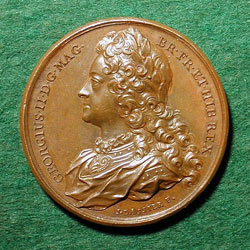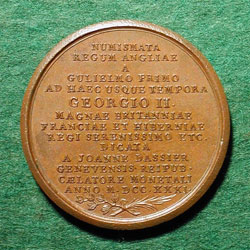

|
GEORGE II, DEDICATION MEDAL DASSIER, Jean: England, 1731, Bronze, 41 mm George II (1683-1760), King of Great Britain and Ireland and Elector of Hanover (1727-1760), was born George Augustus, the son and successor of George I. As Prince of Wales, George quarreled with his father and turned his home into a meeting place for dissident ministers. As king, his politics was dominated by Sir Robert Walpole until Walpole was forced to resign by the machinations of George's estranged son, Frederick Louis. Walpole was replaced by John Carteret (later Earl Granville). George and Granville took Britain into the War of the Austrian Succession (1740-48). The war, however, was generally unpopular and forced Granville's dismissal in 1744. George survived the Jacobite Rebellion of 1745. A year later he appointed William Pitt (The Elder) as prime minister, and it was largely due to Pitt that Britain was victorious in the Seven Years' War (1756-63) against France. Britain's prosperity grew rapidly during George's reign. He was a great patron of the arts and was responsible for bringing the composer George Frederic Handel to Britain. George II was succeeded by his grandson George III. (From O'Brien) |
|